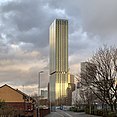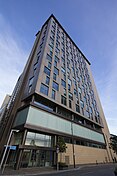St Paul's Church, Peel
| St Paul's Church, Peel | |
|---|---|
 St Paul's Church, Peel from the north | |
 | |
| 53°31′51″N 2°25′34″W / 53.5309°N 2.4260°WCoordinates: 53°31′51″N 2°25′34″W / 53.5309°N 2.4260°W | |
| Location | Manchester Road, Little Hulton, Greater Manchester |
| Country | England |
| Denomination | Anglican |
| Website | [1] |
| History | |
| Status | Parish church |
| Dedication | St Paul |
| Consecrated | December 1876 |
| Architecture | |
| Functional status | Active |
| Heritage designation | Grade II |
| Designated | 29 July 1966 |
| Architect(s) | J. Medland and Henry Taylor |
| Architectural type | Church |
| Style | Gothic Revival |
| Groundbreaking | 1874 |
| Completed | 1876 |
| Construction cost | Church c. £5,000 Spire £2,000 |
| Specifications | |
| Spire height | 165 feet (50 m) |
| Materials | Sandstone |
| Administration | |
| Parish | Peel and Little Hulton |
| Deanery | Eccles |
| Archdeaconry | Salford |
| Diocese | Manchester |
| Province | York |
St Paul's Church, Peel (grid reference SD718038) is an active Anglican parish church in Little Hulton, Greater Manchester, England. It is part of the Diocese of Manchester. It is a Grade II listed building.[1] St Paul's serves the parish of Peel and Little Hulton and with St Paul's, Walkden and St John the Baptist, Little Hulton is part of the Walkden and Little Hulton Team Ministry in the Eccles Deanery and Salford Archdeaconry.[2]
History[]
The church's origins are in Peel Chapel[3] built in 1760 by the Yates family and consecrated as a chapelry in the Parish of Deane. The chapelry became a district parish in March 1874.[4] The old chapel was demolished and the foundation stone for a new church immediately to the south was laid by Lord Kenyon in August 1874.[5] The church, designed by J. Medland and Henry Taylor, was built between 1874 and 1876, consecrated in December 1876 and its tower added in 1897.[1] Construction of the church cost about £5,500 (£460,000 in 2014),[6] and the spire a further £2,000 (£200,000 in 2014).[6][5]
Architecture[]

Exterior[]
The church is constructed in local sandstone from Peel Quarry with a slate roof and bellcote. The church has a north porch and west spire. It is in the Early English Gothic style with Decorated details.[1]
The church is built on projecting plinths and has a nave and four-bay aisles with separate roofs which terminate short of the nave at the west. The bays, are separated by buttresses and each has a pair of two-light windows above a continuous sill band. The two-bay chancel is higher than the nave and has a five-light east window. The four-stage west tower has angled buttresses and a west door above which is a four-light west window. The belfry has paired two-light openings under a broach spire set back behind a parapet.[1] The spire is 165 feet (50 m) tall.[5]
Interior[]
The nave arcade is carried on short cylindrical columns with moulded and decorated capitals. It has a hammer-beam roof and the wide chancel arch is supported on quatrefoil columns.[1] The columns are made of Runcorn and Bath stone.[5] The pierced stone chancel rail incorporates the pulpit made of gypsum or alabaster with green Connemara marble pillars carved into scenes from the life of St. Paul and the lectern with carvings of flowers and ferns and the head of a king at its base.[5]
The church has a reredos made from carved alabaster thought to be from the Blue John mines in Derbyshire,[5] timber pews and a baluster font from the old chapel. Some of the stained glass is by Shrigley and Hunt. There are several 18th and 19th-century wall plaques.[1] A window made of painted and fired porcelain over the font is from the old Peel Chapel.[7] A brass plaque from 1759 on the clergy vestry door, one of several pew plates saved from the old chapel, is inscribed "Geo. Kenyon Esq."[5]
Churchyard[]
The churchyard contains the war graves of two service personnel of the First World War and nine of the Second World War.[8]
Near the church porch is the grave of the Roscoe family, including the head of the family James Roscoe, who operated several local coal mines and lived at Kenyon Peel Hall.
See also[]
References[]
Notes
- ^ a b c d e f Historic England, "Church of St. Paul (1163015)", National Heritage List for England, retrieved 4 December 2012
- ^ Church List Peel, St Paul, The Church of England Diocese of Manchester, retrieved 7 January 2013
- ^ Peel Chapel, The Churches of Britain and Ireland, retrieved 7 January 2013
- ^ Farrer, William; Brownbill, J, eds. (1911), "Little, Middle and Over Hulton", A History of the County of Lancaster: Volume 5, British History Online, pp. 25–34, retrieved 7 January 2013
- ^ a b c d e f g St Paul, Peel, St Paul's Church, retrieved 7 January 2013
- ^ a b UK Retail Price Index inflation figures are based on data from Clark, Gregory (2017). "The Annual RPI and Average Earnings for Britain, 1209 to Present (New Series)". MeasuringWorth. Retrieved 2 December 2021.
- ^ Little Hulton, Greater Manchester, The Churches of Britain and Ireland, retrieved 3 December 2012
- ^ Peel (St. Pauk) Churchyard, Commonwealth War Graves Commission, retrieved 5 February 2013
- Grade II listed churches in the City of Salford
- Church of England church buildings in Greater Manchester
- Anglican Diocese of Manchester
- 19th-century Church of England church buildings
- Gothic Revival church buildings in England
- Gothic Revival architecture in Greater Manchester





